Coronary Artery Bypass Grafting (CABG)
The operation takes 3-4 hours to perform, and begins after general anesthesia is induced. Patients are completely asleep during the entire course of the operation. Physician assistants remove saphenous vein through incisions in the legs (see Figure 1). The length of the incision is dependent upon the length of vein required to complete the necessary number of “bypasses” (i.e., 5 bypasses require more vein than 2 bypasses). There are many “redundant” veins in the leg. Once some vein is removed, the other veins in the leg take over for the missing vein. Once the vein has been removed from the leg, it has the appearance of a long tube or “conduit”. The vein will be divided into shorter segments, each of which will be used for individual bypasses.
As vein is removed from the leg by a physician assistant, the surgeon simultaneously opens the chest by dividing the breast bone or sternum, affording excellent exposure of the heart (see Figure 2). An artery behind the sternum, the left internal mammary artery (LIMA) is taken down and one end prepared for bypass grafting (see Figure 3). Tubes or cannulae are inserted into the heart and major blood vessels surrounding the heart in preparation for cardiopulmonary bypass with the heart-lung machine.
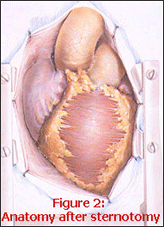
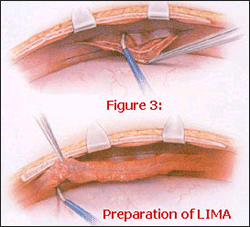
The diseased coronary arteries are now identified and opened beyond the level of the blockages (see Figure 4). The open ends of the saphenous veins and LIMA are now sewn to the openings in the coronary arteries using very fine non-absorbable suture material, called “distal” anastamoses (see Figures 5, 6). Surgeons wear special magnifying lenses to see the delicate suture and small vessels.
Because the “inflow” through the LIMA is left intact, as soon as the LIMA anastamosis is completed, blood flow is established to that region of the heart. A vein graft, however, is harvested as a “free graft” and has no “inflow”. Therefore, after the “distal” vein graft anastamosis is constructed, the other end of the vein graft is sewn to the aorta (the main artery leaving the heart) to establish “inflow”. These are called the “proximal” anastamoses. After this stage, blood flow has now been established beyond all the blocked arteries.
The heart-lung machine is then gradually weaned off, and the patient’s heart and lungs resume their normal functions. The cannulae are removed from in and around the heart, and the sternum and incisions are closed. Drainage catheters are placed around the heart. These are usually removed after 24hrs. Temporary pacing wires to regulate the patient’s heart rate are sewn to the surface of the heart. These are removed before the patient goes home.
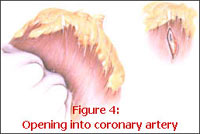
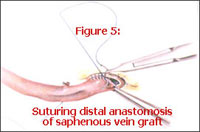

Traditionally, vein harvesting is accomplished through a lengthy surgical incision in the leg(see Figure 7) . But in recent times leading Surgeons have been practicing a minimally invasive procedure called Endoscopic Vein Harvesting (see Figure 8).
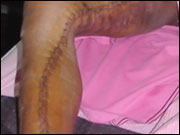
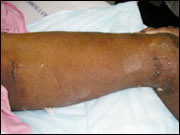
 Ask Doctor
Ask Doctor